Barzam A.B. Automation in Electrical Power Systems (Системная автоматика)
Подождите немного. Документ загружается.

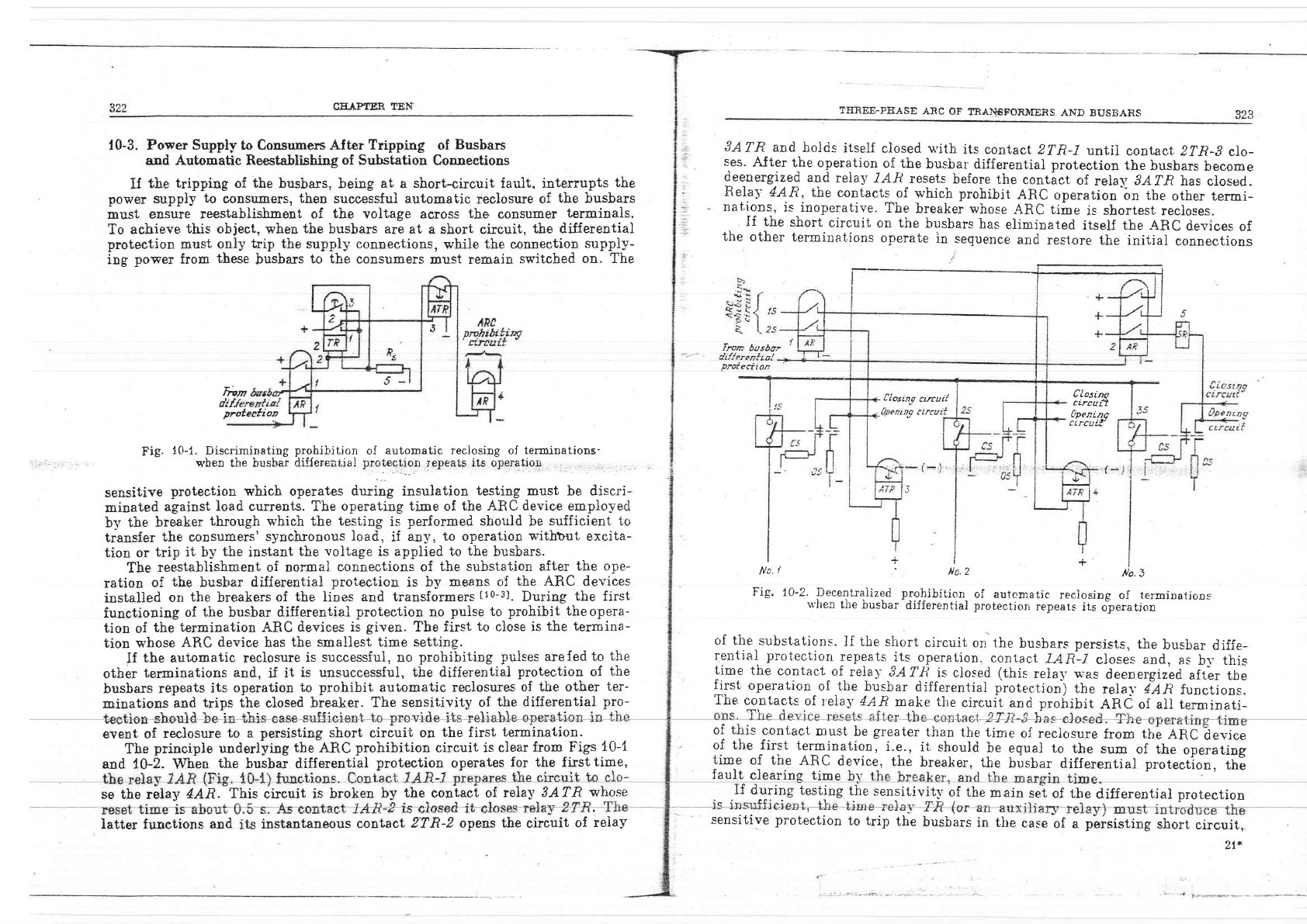
CE.A.PTER
TEN
10-3.
Power Supply to Consumers After
Tripping
of
Busbars
and Automatic Reestablishing
of
Substation Connections
If
the
tripping
of
the
busbars, being
at
a
short-circuit
fault,
interrupts
the
power supply
to
consuners,
then
successful automatic
reclosure of
the busbars
nust
ensure
reestablishment of
the
voltage
across
the
consumer
term.inals.
To
achieve
this object, when
the
busbars are
at a short
circuit,
tbe differential
protection must
only trip the supply connections,
while
the connection
suppiy-
ing
power
lrom
these
busbars
to
tbe
consumers
must rem.ain
srritched on.
The
lmm
dif.
proteetion
Fig.
10-1.
Discriminating
prohibition
oI
automatic reclosing of
terminations'
q'hen
the busbar differeai,ial
protection
repeats
its
operatioii
sensitive
protection
wbich operates
during
insillation
testing
must be discri-
miuated
against
load
currents. The
operating
time
of
the ARC device emplo-ved
b-v the
breaker
through which the
testing
is
performed should
be
sufficient to
transfer
the consumers'synchronous
load,
if
any,
to operation
w-ithbut
exeita-
tion or
trip it
by
the
instant
the
voltage
is applied to
the
busbars.
The
reestablishment
of
normal
connections of
the substation after
the ope-
ration
of
the
busbar
differential
protection
is
by
means of
the
ARC devices
installed
on
the
breakers
of
the
lines
and transformers
t10-31.
During
the
first
functioning
of
tire
busbar
differential
protection
no
puise
to
prohibit
theopera-
tion
of
the
termination
ARC
devices
is
given.
The first
to
close
is
tbe termina-
tion whose
ARC
device
has
the smallest
time setting.
THREE-?EASE
ARC
OF
TRAN6FOR}TERS
AND
BUSBARS
DOe
SATR
and
holds
itself
closed u'ith
its contact
2TR-L
until
conract,
l?R-S
elo-
ses.
AJter
the operation
of the
busbar
differential
protection
the
busbars
become
deenergize!
and
reial' 7AR
resets
before
the
contict
of
reiay
SATR
has closed..
Re1a5'
4AR,
the
contacts
of
which
prohibit
ARC
operation"bn
the
other
termi-
nat.ion-q,
is inoperat'ive.
The
breaker whose
ARC
time
is
shortest
recloses.
if the
short
circuit
on the
busbars
has
eliminated
itself the ARC
devices
of
the
other
terminations
operate
in
-ceguence
and
re-qtore
the
initiaj
connections
From
busbor
Cz//ereniial
proiection
Closing
ctnuil
0pentn-e ctrcuit
Clostno
cLrcuit
0penino
time
of
reclosure
from
tlre
ARC
device
of
the
operating
protection,
the
If
t,he automatic reclosure
is
successful,
no
prohibiting
pulses
arefed to
other
terrrinations
and,
if it
is unsuccessful,
the differentiai
protection
of
busbars repeats
its
operation
to
prohibit
automatic reclosures
of
tire
other
minations
and
trips the
elosed
breaker.
The
sensitivity
of
the differentiai
event
of
reclosure
to a
persisting short
circuit
on
the
first
termination.
The
principle
underlying
the
ARC
prohibition
circuit
is clear
from Figs
10-1
of the
substations.
If the
short
circuit
on the
busbar.s
persists,
the
busbar
diffe-
qential
protection
repeats
its_o_peration.
contact
I.A,R*.1
close*.
and.
as
b]- this
time
tire
contac,t-of.
relat,
SAf
f
is
ciosed
(this
rela\:
rras
deenergized
after
tbe
first
operation
of
tiie
busbar
differential
protection)
the
relal'
{AR
frn"tions.
The
contacts
of
lelay
44R
make tlre
circuit
and
prohibit
ARC of all
trrniin^ti-
of
this
contact
must
be
greater
than
the
of the first
terminationl
i.e..
it,
should
time
of the
ARC
device,
the
breaker,
the
the
ter-
pro-
and t0-2.
When
the
busbar differential
protection
operates
for the
first
time,
I
se the
relay
4AR. This
circuit is
broken
by
the
coutact of
relal' SATR
whose
be
equal to
the sum
fault
ciearinE
time
bv
the
busbar
differential
If during
testing
the
sensitivlty
of the
main
selt
of the
differential
protection
the
case
of a
persisting
short
circuit,
J- L
?
No.
{
l,lo.
2
/to.
J
Fig.
10-2.
Decentraiized
lgo]ribition-
oI
autcmatic
rec.losing
oI terminatiots
uiren
tlie
busbar-differential
protection
repeats
its
o*pe.ration
Iatter
functions and instantaneous
A t,-4 rD UtftDcu tu ult
contact
2'TR-2
opens
the
circuit
of
reiay
___v-v4,
v,
r(
l.vl
qt
sensitive protection
to trip
the
busbars
in
2!*

CEAFTER
TEN
Iil
-
4.'
lAutomatic
Reestabli"fri"g,of
P
ower
Station
Connections
When a
short
circuit
of busbars persists
due
to
a failure
of the
breaker
at
one
of
faulty
phase terminations.
when
the immediate
automatic
reclosure
is
unsuccessful.
When
the
back-up
device
of
the
breaker
lunctions
after a failure
of the
bre-
aker
of
an autotransformer (transformer,
generator-transformer
unit)
and
after
its
damage.
tor'mprove
ttre
se-nsrtffit1'
of
thgtusbar
diff-erenlial prolection
use is
maele
of an
auxiliary protective.
element
having
an operating
current
rn'hich
is
not
t
The
ARC
p.rohibiting
circuit
of the
brcaker
of termination
No.
3
can
be made
in
the
it
is
first to
be closed
Iess
than
THREE-PIIASF
ARC
OF
TRANSFORMERS
AND BUSBARS
discriminated
against
-
unbalanee
currents from
external
faults
ancl
hunting.
This
eiement
operates longer
than
the
complei,e
ARC
cycie.
goJng
lines
onl,v is necessary,
as tire
dutv
personne]
can
be responsibie
for
the
subsequent
closure
of the
generators
and
the generator-transformer
units.
10-5.
Three-Phase
ARC
of Translormers
The
ARC devices
of
transformers
are intended
to recover
the
power
supolv
after
emergencrt
trippinE
of a feedinq
transformer
for anv callse .,i,h"" thari'in-
The
AFC devic.es
of transformers.differ
mainif in
the
starting
aad blocking
*tT;,r1;;
ng
ol
att
ARC
d.euic:e,
i*tn the
moin
o,
o*r,-up
protection
deui,ce
on th.e
transformcr
tunctions.
pronrot€'s
its autonatic
reciosurr
v:hatevel
the
fauli
(internal
faults
included).
A
disadvantage
here
is
tha{ the
fauity
transformer
mayreclo-"e
wjth
t,he
risk of additiorrat
dapage.
This
method
may iiod
irs
appli.
ea[ions rn'here
u-se
is
made
of
quick-aeti^On
protection
unitS
or
s'bere proviSiin
is
made fs1
-speedilg
up
tlp
action of the back-up protection
units afier
the
ope-
ration
of
tbe
AFC devices.
ARC
prohibittng
in
operatiorz of
the
signal el-em-ent
ol
the
oil
pressure
protecti.on
is
u.sed
to
prevent
aut,omatic
reclosure
in
the
case
of internal damage
to
trans-
rormers.
tne
slgnal element
oI tlre
oll
pressurc
protection
function-q at the pre.-
sence
of
gas
in
the
relal:
or in case of oiJ leakage.
\Vhen
external
short
circuits
occur.
the
signal
element
misoperate-s far
more
rarelv
than the
tripping
ele-
ment.
Therefore,
prohibition
of
ARC operation
by the
signalling
contact of
trinni
the
transformer
breaker
for
anv
reason.
exceot
internal f
u pur a
Ltug
'uime
oi ihe
ARC
devices
shouiri
be
somewirai.
grearer
i,han
tire
of the
signal element
of tlie
oil
pressure
protection (3
to
5 s).
324
f
uuu
auls
ul
t
- I t n -- _
,l
tAn are
by the
ARC
device
(the
o
time
of ARC
device No.
3 is
ting
time
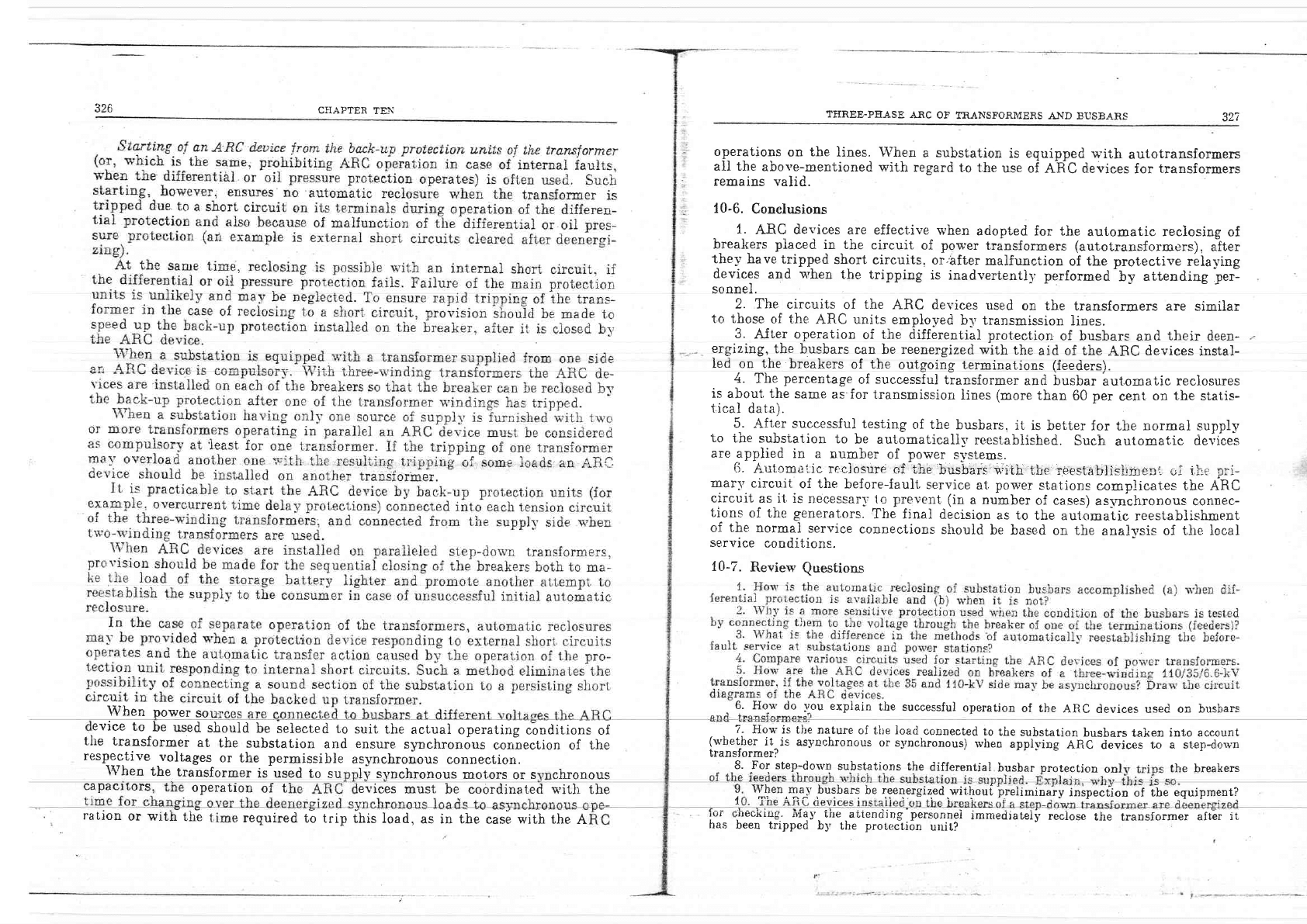
dzo
C}I.A,PTER
TESi
\4lhen
Dower
so
evice
to
be
used
should
be selected
to
THREE-PEASE
ARC
OF
TRANSFORI\IERS
AND
BUSBARS
operations
on
the
lines.
When
a substation
is
equipped
*'i*uh
autotransforners
ali the
above-mentioned
with
regard
to the
use
of
ARC devices
for
transformers
remains
valid.
10-6.
Conclusions
1.
ARC devices
are effective
when
adopted
for the
automatic reclosing
of
b_reakers
placed
in the
circuit
of pou'er
transformers (autotransformer-s),
after
t-hey
have tripped
short
circuits.
or.after
malfunction
of
the
protective rblaying
devices
and
v'hen
the tripping
is
inadvertenlil:
performed
by
attending per-
I
sonnel.
2. The
circuits
of
the
ARC devices
used
on the
transformers
are similar
to those
of the
ARC units
emploi'ed
bv transmission
lines.
3.
A-fter
operation
of
the
differential
protection
of busbars
and
tireir
deen-
ergizing,
the
busbars
can
be reenergized
with
the
aid of
the
ARC
devices
instal-
Ied on the
breakers
of the
outqoing
t,erminations
(feeders).
4.
The
percentage
of
successful
transformer
and busbar
automatic
reclosures
is about, the
same
as for
transmissior.r
lines
(more
than
60
per
cent
on the statis-
tical
data).
5. After successful
testing
of the
busbars,
it
is better
for
the
normal supply
to
ihe subsiation
to
be automaticall-v
reestablished.
Such
automat,ic
Oevi'ce!
are
appiied
in a
number
of
power
s-vstems..
ij.
Ar:toma'r,ic recJosure
of the'busba'rslwith
tbe
qee-qt;ablishmeni-
,;i
t.hr,
pri-
marv
circuit
of the
before-fau1t,
service
at.
porver
stations
complicat.es
tbe
ARC
circuit
as it. is nec.essar\:1o
prevent (in
a number
of cases)
asyn-chronous c.onnec-
tions
of the generat,ors.
lfre final
decision
as to
the
automatic
reestabiishment
of
the
normai
service
connections
should
be
based
on the
anah,sis
of tire local
service
conditions.
10-7.
Review
Question-s
6.
Ho3'
do
you
explain
the
successful
operation
of t,he
ARC
devices used on
busbars
7-
Hou'is
tlre nature
of
t,ite load
connected
to
ti-re
substation
busbars taken into
account
('rvbether
it^is
asynchronous
or s5,ns[s6rous)
rvhen
applyrns
,tnC
devic,u.
to
" "t.p-aoio-n
transformer?
8.
Io{
step-don'n
substations
the
differential
busbar
protection
onl
the breakers
When
.{ly .buqbars
be reenergized.withoui
p,reliminaiy
inspection
of the
equipment?
UI
327
the
transformer
at
the
substation
and
respective
-voltages
or the pernissible
suit the
actual
operatirrg
conditions
of
ensure
synchronous
corrnection
of the
asvnchronous
connection.
When
the
transformer
is^used
to
su
Iv
svnchronous
mot,ors
or
s
chronous
capaclf,ors,
operation
of t
evices
must
be
coordinated with
the
I
t
ratroD
or with
the
required
to
trip ihis load,
as in the
case
with
the
A
has
.L--l-:--- rr__,
rl -
:
---------
rrreulirug.
rl,taJ/-
rne
aLrenorng
.
personnel
tmmedratel5'
reclose
the
transiormer
alter
it
been trippe
d
b5' tire
protection
unit?
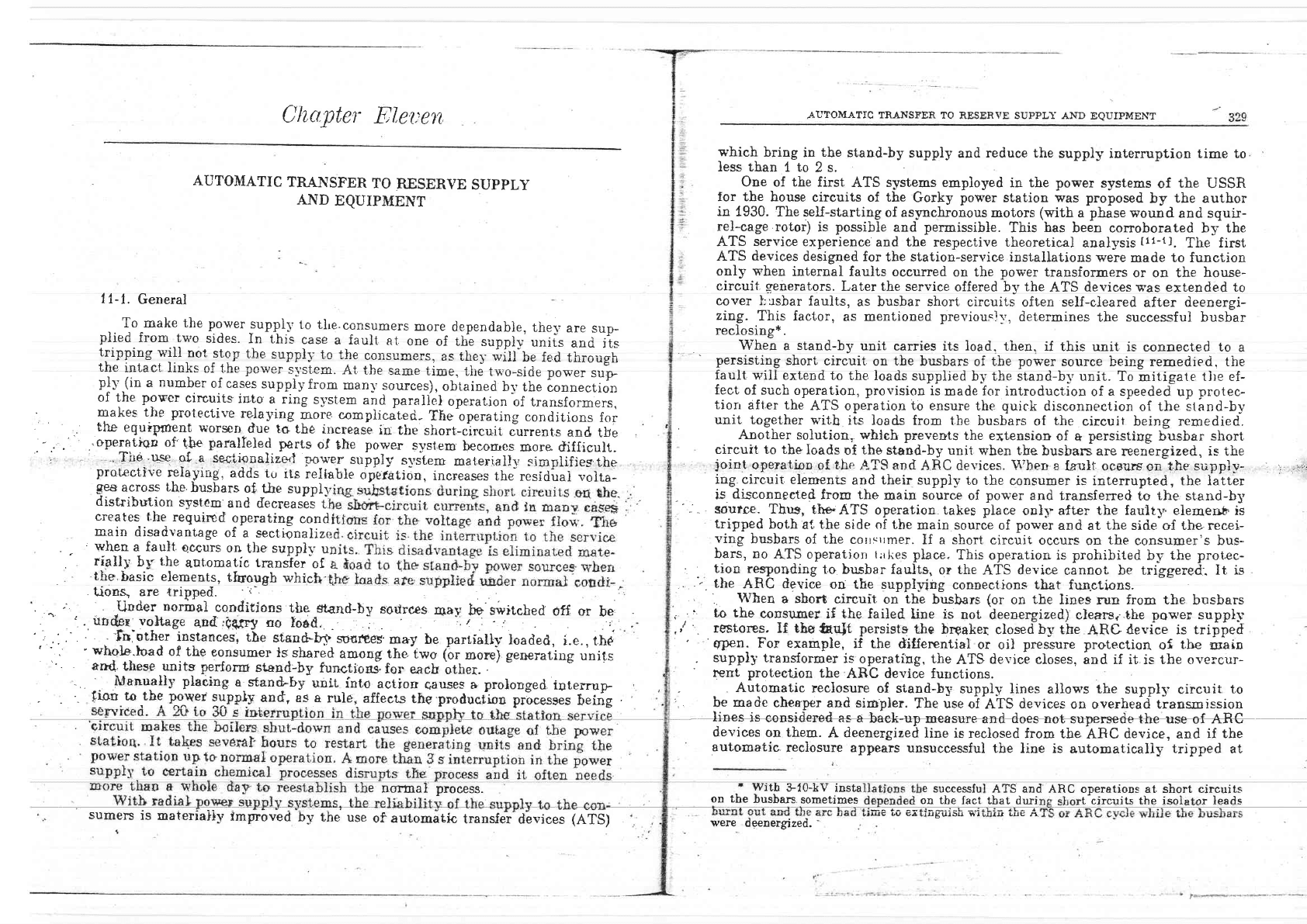
Clt
cr.pter
El,et:en
AUTOMATIC
TRANSFER
TO
RESERVE SUPPL-I* AtsD
EQUIPMENT
which
bring
in
the
stand-by
suppiy
and
reduce
the
suppiy interruption time to
Iess than
t to
2 s.
One
of
the
first
ATS
systems employed
in the
power
systems
of
tbe
USSR
for the
house
circuits of the
Gorky
power
station was proposed
by
the author
in
1930.
The selJ-starting
of asynchronous
motors
(with
a
phase wound
and squir-
rel-cage
rotor)
is
possible
and
permissibie.
This
has
been
corroborated
bf
the
ATS
service
experience
and the
respective theoretical
anaiysis
t11-{1.
The first
ATS
devices
deiigned
for the station-service installations
wele
made to function
only
s'hen
internal
faults occurred
on the
power
transformers
or on the
house-
circuit
generators.
Later the service
offered by
the
A?S
devices
was extended to
cover l:usbar
faults,
as
busbar short
circuits
often self-cleared
after
deenergi-
zing-
This factor,
as mentioned
previouslv,
determines
the suceessful busbar
reclosing*.
AUTOMATIC
TRANSFER
TO
FNSBRYE
SUPPLY
A]VD
EQUIPMENT
11-1.
General
To
make
the
power
guppl.r'
to tire.con$lmers
more,
dependable,
the-v
are
sup-
plied
from two
sides.
In
this
case
a fault
at.
one
of tlie
supply'
uniir
-and
jis
tripping
willlot
stop
tbe
suppl-v
to
the
ccnsurners,
as t,hey *itt'U.
fed
through
thg
intaCt
linl.:s of t.hc nn\rro!-
epeton
Al
+Jro
o+:r- *i*-. {'!.^
a==-- -:r
p
I
-r,
(
i
n
;
;
;;;;'"
;
i
;;.
il
il ;ii:
ilil
fi l'
".:.
;;;
Jl,-"iJ
il. u"01,:i
I
I
#ffi
;
ffi
of
the
poFcr
circuits
into
a
ring
svstem
"nd
paraliel
operation
tf
transformers,
'
makes tire protective
relaying
poT
campiicateri-
The'operating
conditions
for
tlte
equipment
uorserr,
due
tG
the increase
in
the
short-circuit
currents
and
1ys
t,
.. Tire.r}-se
g[
a
se{iiplalize,l
F'o1'el
suppl-v
s1'sl"m
marerially
simpiifiestfre
proLective
reialing,
adds
tu
ifs
ieltabie
opefat,ioc,
increases
the
residlai
lolta_
ges
across Lhe
husbars
of
tle suppll
distributi6n
.s5rst€rB
and
decreas-ei
i.
creates
t.he
requircd
operating
cond
main
disadvantage
of
a
-sectionalizt
'
when
a fault.
qccurs
on
the
suppll'
u
rially
by
the
automatfc
transfer
of
the,
basic elements,
through
which
tiong
are tripped.
"i-
Under
norliai
condition-s
tire stand-by
sodrces
lcay
!*
switched
off or
bel
.1
'..onder
vohage
and;gggry
no
load.
.
.,
:.
1
.
-.----.*
--.
"-
.,
'
.'
.'.
'
.
frr,other
instances,
tle
stsn&ht-suultes
ma.y
be
partiall-v-
loaded,
i.e., t,hp
'
'
,.
'
wlrol',e.hcad
of
the
eonsumer
is
shared
arDotrg the- two
('or
more)
ge$eratiug
units
and
these
units
perform
stand-by functioni.for
each
other.
Manually
placing
a
stan&by
unit fnto
actiotr
c,auses
a
prolonged
interrup-
'
ti.orr
to.the
ir:"lt
*pply
and, as
a
rrie,
"nr"G
ine:p"qd""t.o
pri"-rr""
n"it
g
e
nolnal process.
sumers
is
materiaily
improveri
by
the
When
a
stand-by
unit carries
its
ioad.
then. if
this unit
is
connected
to
a
persist,ing
short
circuit
on
the
busbars
oi the
power
soluce
being remedied. the
iault
wiII
extend
to the loads
supplied
by the stand-b1' unit.
To
mitigate
tjre ef-
fect
of such
operatiou,
provision
is
made
for
introduct,ion
of
a
speeded up
protec-
tiorr
aft,er the
ATS
operation
to ensure
the
quick
disconnection
of
the stand-by
unit together
witb
its loafu from
t.he busbars
of
the
circuit being remedied.
'
Another solution,
whlch
prevents
the
extension
of
e
persistiug
busbar
short
circuit to the
Ioads
of
the
stand-by unit
when the
busbars
are
reenergized,
is the
':iointopelationoft.br.ATsandARCdevices.\1'henalat}tocsnrsont.hesupp}y.
ing circuit
elemenis
and their suppil-
to the
consumer is interrupted, the latter
-
ts
disconnected.
from the
maiu
source
of
power
and transferred
t,o
the
stand-by
'
-
-
soutr.e. Thus,
t}re-ATS
operation takes place
onlv after
the faultl" e.lementr'is
tripped
both
at
the
side
of
the
main
source of
power
and at
the
sid.e of the recei-
ving
busbars
of
the
corrsrrmer.
If
a short
circuit
occurs
on
the
consumer's bus-
bars,
no
ATS
operation t;rkes
place.'Ihis
operation is prohibited
by
the prot.ec-
.
tion responding
t.o busbar faults,
or
the
ATS
device
cannot
be triggered:. It, is
.
'..
t,he
AffC device
on
the
supplying
connectlons
that functions
'.
When
a
short
cirtuit
on
the
busbars
(or
on
the
lines
run
from the
busbars
.
.''
to the
corsumer
if the failed
line is
not
deenergized) clearsr-.the
power
suppiy
,,/'
reistorcs.
If tbsdu.ult
persists
the
brtaker
closed-b-v
the ARCdevice is
trifrped
.
suppiy transformer
is
operating, the
ATS
device closes,
and if it
is
the
overcur-
'
t€rt protection
the
ARC device
functions.
Automatic
reciosure
of stand-by
supply lines
allows
the
suppl-v
circuit
t,o
Liu€sjs
eensidercd as+rlaet-upreastre,
and
doernot;€trpersetitr*he
erseof
ra.R€
devices
on
them.
A
deenergized
line is
reclosed fron
the
AFC
device, and
if the
automatic
reclosure
appears
unsuccessful
the line is
automaticaliy
tripped
at
'
With
&10-kV
insta
on the
busbars
sometimes
e
successlu AfS and ARC
operations at short
on
tbe
fact tbat duri
were
deenergized.
-
circuits
rr
leads
use
of
aul,omatie
transfer devices
(ATS)
h^ +^ ^-
gE
&U
EI
* --: ^L --i
!5
trrDq
rt r
:- aL^
I
Ill
|,uts
/1
t circuits
the isol
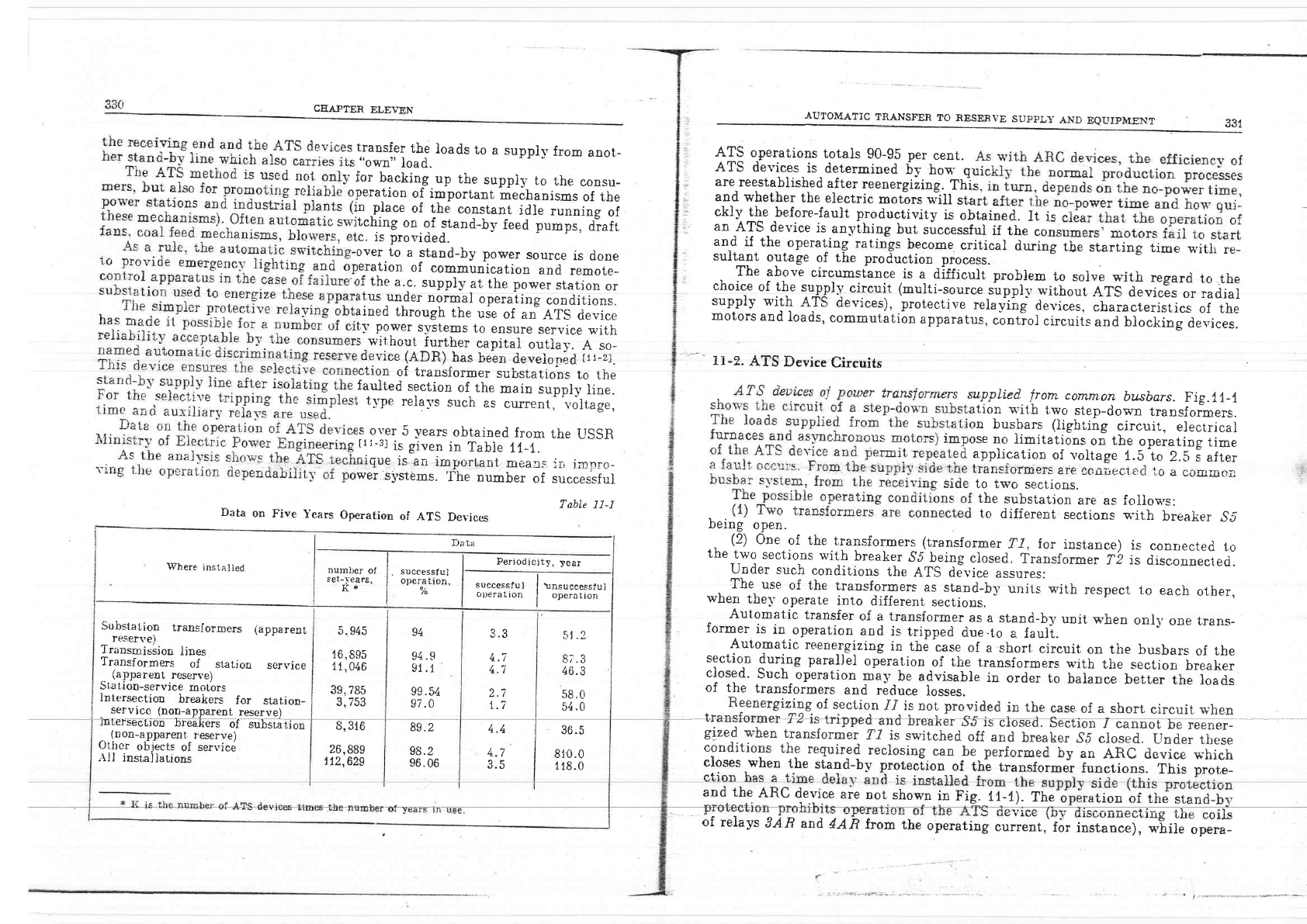
CEIAPTER
EI,E\EN
AUTOMATIC
TN.ANSFER
TO
RESER\;E
SUPPLY
AND
EQUIP}I.ENT
21
transfer
the
ioads
to
a suppl;,
from
anot_
"ownttload.
[or
backing
up
the
suppiy
to
the
consu_
reration
of important
mechanisms
of
the
n
-place
of the
constant
idie
running
of
tching
on
of
stand-b-v
feed
pumps,
diaft
c.
is provided.
cver
to
a
staud-by
power
source
is
done
eration
of
communication
and
remote_
rf
the
a.c.
supply
at
the
power
station
or
rtus
under
normal
operaling
conditions.
lined
through
the
uie
of
an-
AT_S
device
bv power
svstems
to
ensure
service
u,ith
: *'ithout
further
capitai
outlav.
A so_
de.,'ice (ADR)
has
beln
develoneti
t1t-zl.
^+i^-. ^f r----I
uLrur.r
ur Lr.aIIstormer
suEstatlons
to
the
faulted
section
of
the
main
supply
Iine.
,
t-vpe
relal's
such
as
cunent,
'uojt"g.,
,s
over
5
years
obtained
from
the
USSR
t1r-31
is given
in
Table
{{-1.
aique
is
an
important
meats
irr
impro_
wer
systems.
'Ihe
number
of succes-"fu}
A!=s
o_perations
totals
90-95
per
cent.
ATS
devices
is
determined
bV
hou.
q.
are
reestabiished
after
reenergizing.
Thi
and
whether
the
electric
motirs
r^7in
str
ckly
the
before-fault
productivity
is
obtainea.
ti
I
an
ATS
device
is
anything
but
successful
if
the
co
T'q {-tf-.-9n.t"ting
ratings
become
critical
during
tbe
starring
time
wit}r
re-
sultant
outage
of the
production
pfocess
The
above
circumstance
is
a difficult
problem
to
solve
with
regard
to
.the
choice
of the
lufPlrl
circuit (multi-sour".
ritppty
without
ATS devices
or radial
supply
with
ATS
devices),
protective
reiayiirg-
deyices,
characteristics
of
the
motors
and
loads,
commutation
apparatus,
cbntiol
circuits
and blocki"g-
a*ices.
ii-2.
ATS
Device
Circuits
upplied
from
cornm.on
busbars_
Fig.l1_l
rtion
s'ith
t,wo
step-do*-n
transfoimers.
rn
busbars (iighting
circuit,
electrical
)se
no
limitations
on
the
operating
time
application
of voltage
1.5-Lo
2.5 i
after
transfofmers
are
cooijec.ied
to
a
c,f,rnulcil
"iJ::r:?:t
,i'"1'
are
as rorrov,s
:
being
open.
different
sections
s.ith
breaker
sJ
.
(2)
One
of the.t,ransformers
(transformer
71.
for
inst,ance)
is
connected
to
the
two
sections
with
breaker
,SJ
being
closed.
tr"nsform
er
TZ is
disconnecteci.
Under
such
conditions
the
ATS divice
assures:
The
use
of
the
tran-qformers
as
stand-b-v
units
v,ith
respect to
eacir
other,
when
thel'
operate
into
different
seciions.
'
---
Automatic
transfer
of a transformer
as
a
stand_bl,
unit
when
onl;,
one trans-
forrner
is
in
operation
and
is
tripped
due.to
a-fault.
Automatic
reenergizing
in
the
-case
of
a
short,
circuit
on
the
busbars
of
the
sgctio,n
during
parallel
operalion
of the
transformers
with
tiie
section
breaker
closed'.Such.operation
Fal'be
advisable
in
order
to
balance
better
the
loads
oI
the
translormers
and
reduce
losses.
Reenergizing
of
section
/,I is
not provided
in the
case
of a sbort
circuit
w-iren
t'ralsJ+rmer49
isJripped
arrd
breaker
,9,1
is
closed.
Se.c,tiron
/r::cannbtFe
reeneF
gize-q
when
transformer
TI is
switched
off
and
breaker.Sj
closed..
Llnder
these
conditions
the
required
reclosing
can
be performed
bv
rn
-tRC
device
rn,hich
:l:::. Jl.: .r.h_.
'11?d-by
prote9ii9n,,oi.
rh;
;;;;r"r;"',
;;;;;;;;r.
Tffi
;;;;;:
and the
ARC
device
are
not
shown
in
Fig.
LL-l).
The-o
tion
of
the
stand-b
9YIUg
f
\
or
COIIS
Table
11-1
Data
on
Five
Years
Operation
of ATS
Devices
Where
installed
Periodicity,
year
numirer
Of
set-)'ea
rs,
Ii*
successfu
l
operation,
oi
Substation
translormers
(apparent
re-serve]
Transmission
lines
Transf
ormers
of
staljon
seryice
(apparent
reserve)
Stat.ion-service
motors
lntersection
breai<crs
for
station-
service
(non-apparent
reserve)
ElerseefiO!
breaEers
of
substa
_
(non-apparent,
r.eserve)
Otitcr
oEjects
of
service
..\!l
instailarions
5.945
1 6,
Eg5
17,046
39,795
3,753
8,316
26,
g8g
112,629
J{
94
.9
Q4
,l
99
.54
q7A
89.2
98.2
96.06
51.2
87.3
46.3
s8.0
54.0
.fo.c
810.0
t r8.0
J..f
4.7
4.7
2.7
'l=
I. '
4.4
1-l
,J.
C
I
successful
|
\nsuceessfu)
opera!ton
I
operation
of
relays
3AR
and
4Ak
from
the
operating
current,
iisconnec'oing
'ui
instance),
u'hile
opere-
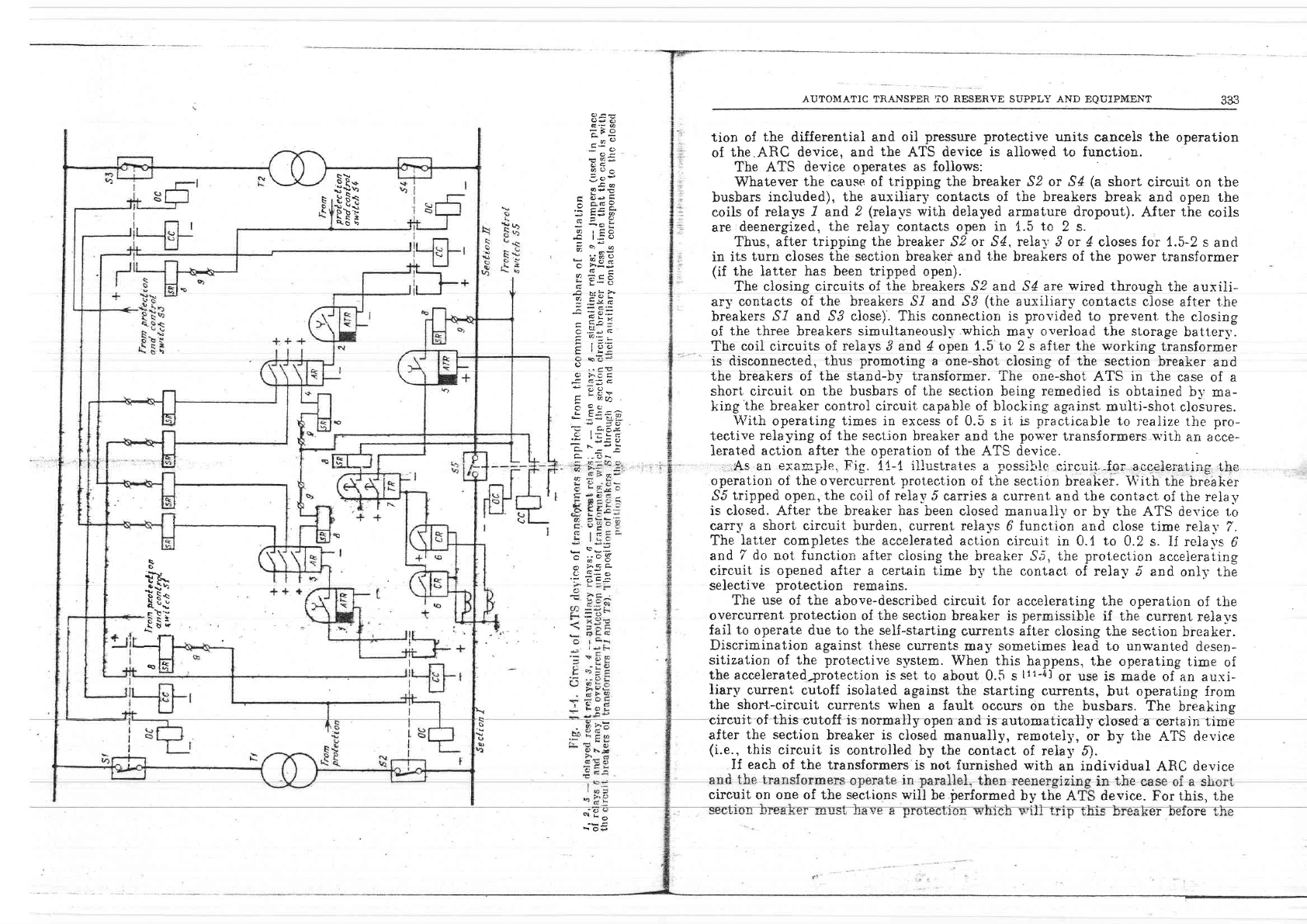
$i*
r*I
\s;
\
o
$
&$i
r\':
*E$i
r
-1
ql*
AUTO}IATIC
TRANSFER TO RESERVE SUPPLY
AND
EQUIPMENT
tion of
the
differential
and oil
pressure
protective
units
cancels
the
operation
of
the.ARC device,
and
the
ATS device is allowed
to
function.
The ATS
device operates as follows:
Whatever
the cause of
tripping the breaker 32
or 54
(a
short
circuit
on
the
busbars
iucluded),
the auxiliar-v contacts
of
the breaker-s
break and open the
coils
of relavs
.Z
and
2
(rela)'s
with
deiayed armature dropout).
After
the
coils
are
deenergized,
tbe
relaSr
contacts open in
1.5
t,o
2
s.
Thus,
after tripping
the
breaker
52
or 54. rela-r, 3 or
4 closes
for
1.5-2
s
and
in
its
turn closes
the
section breaker and
the
breakers of the
power
transformer
(if
the latter has
been
tripped
open).
The
ciosing circuits of
the breakers ,S2
and 54 are
*'ired
through
the
auxili-
ary
contacts
of the breakers S/
and
SJ
(the
auxiiiary contacts close
after
t.he
breakers,9T
and SJ ciose). This connection is
provided
to
prevent,
t,he
closing
of
the
three
breakers simtrltaneousll-
which
may
overload the storage
batter5'.
The
coil circuits of
relays
3 and 4 open
1.5 to
2
s after the working
transformer
is
ciisconnected,
thus
promoting
a
one-shot
ciosing
of
the
section
breaker
and
the breakers of
the stand-b-v transformer.
The one-shot
ATS
in the
case
of a
short circuit on
tbe
busbars
of the section
being
remedied is obtained
b1'
ma-
king
the
breaker control circuit
capable
of
blocking against
muiti-shot
closures.
With
operating times in
excess
of 0.5 s
it is
practicable to
realize
tlie pro-
tective
relaying of
the
section
breaker
asd
the
power
tiansformers with
an acce-
lerat.ed
action
after
the
operation of
the
ATS device.
,,As
an
exanple.
Fig.
11-1
i]lustrates
a possil'Ie
crrcuit.-foi
a,ac,eierating.,the
operation oi the
overcurrent
protection
of
the
section breaker.
\['ith the
ilreaiter
55
tripped
open,
the
coii of rela1,' 5
carries a
current,
and
the contact
of
the rela-v
is closed. After
the
breaker
has
been closed
manualll'
or b_v the ATS
device to
carr],
a short
circuit burden,
cunent relay-s
6
function
and close time
relav
7.
The
}atter
completes
the accelerated action
circuit in 0.1 to
0.2 s. If
reiavs
6
and
7 do
not functiorr
after ciosing
the breaker,SS, the protection
acceieraiing
circuit
is opened
after a certain time
by
the
contact of reiay
5 and
oniS'the
selective
protection
remains.
The
use
of the
above-described
circuit
for
acceierating
the
operation
of tlie
overcurrent
protection
of
the section
breaker
is
permissibie
if the
current
relal's
fail
to
operate due to the self-starting
curents after closing the section
breakei.
Discrimination against
these
currents
may
sometimes
lead
to un*'anted
desen-
sitization of the
protective
system.
When this
happens,
the
operating time
of
the acceleratedprotection
is
set
to
about
0.5 s
[11-4]
or use
is made of
an au.ri-
Iiary
curren"
cutoff
isolat,ed
against
the
starting
currents,
but
operating
from
the shor't-circuit
currents
wiren
a
fault occurs
on
the
busbars.
The
breakins
eireuitof
this
cutsff
isnormaLlyopen
and is
autonnatically
closed
a
certain timi
after the
section
breaker
is
closed
manually, remotely,
or by
the
ATS devie.e
(i.e.,
this
circuit
is controlled
by
the
contact
of relay.f).
If
each of the
transformers
is not furnished with
an individual
ARC
device
be
irerformed
by the
A
device.
For
this, the
.J.aJ
9Ee
9JQ
g.:
@
=6o
=
.5'- o
EE*
qa-
--
=@
O+-
E
Or=
-, C.E
s
.=
tr=*
r
=e:i
6
:,.,
i
6
,iE
7
o'-
-
l.;-e9
o
>iJ
r
EsF
€.'
-c
urh
ts
v'
trJ2
^
-::-
::X
6.S-;
=
@'=-
/ loo
F
t'=
C sE-
a--
o
hc=
vx-
=
-6ri
a e..
i
p!:;
L
.:*
>Ji-
_+-=!^
e,LO:
.2
IE:
E
?
*-;F
E._5*-
c';aE
.T
5E:
\
o
_c)
sti
circuit
on
one
of the
sect.ions wil
T?N
a7
nofnFA
vt
vLIvI
I
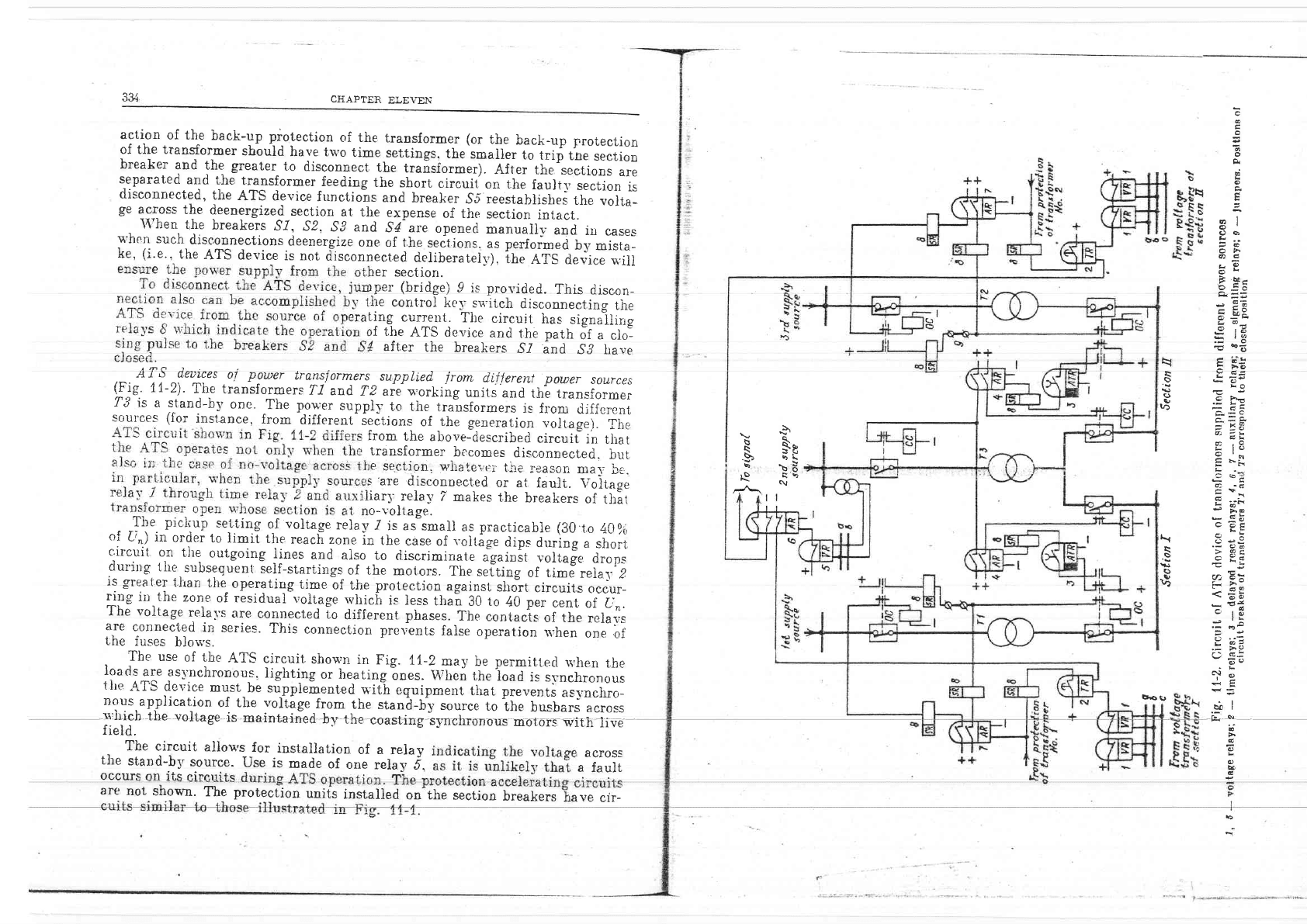
JJ.l
CHAPTER
ELE1IEN
action of the
back-up
protection
of the
transformer
(or
the
back-up
protection
of the transformer
should
have two
time-settings.
the'smaiierto
lrip
tne
section
breaker
and the
greater
to
disconnec,t
the
traisform.t
Aii.;
the
sections
are
separated
and
the
transformer
feeding
the
short
circuit'on
the
faultS'r."iion
l*
clisconnected,
the
ATS device
functio*ns
and
breaker
,S5
reestabiisiiei
thu
.,rottr-
ge
across
the
deenergized
section
at
the
expense
of
the
section
intact.
\4rhen
the
breakers
,9.I,
52.
S3 and
S4'ale
openea
*"nu"fiy-
ana
ir
case-c
u'hen
such
disconnections
deenergize
one
of t,he
sections.
as perfoimed
by
*i.1"-
ke,
(i.e.,
the
ATS
device
is not
disconnected
deliberatet5),
in.
IiS
aer,llce
vti]
her
section.
rper
(bridge)
I
is
provided.
This
discon_
ire
control
ke1-
sri.itch
tiisconnectins
tire
Ling
current.
TIie
circuit
has
signallirre
rf the
ATS device
and
the
path
if a
ctol
I
after
the
breakers
.Si
ind
,S.?
have
\.J U5L? tl ,
ATS
deuices
oi
power
transformers
^supplied
lrorn
d.i..t'f
erent
power
sources
flg
t1-2).
The transformers
I-l
and,
T2 aie, s,orking
units'and
thl
transformer
TB
is
a stand-bJ,
one.
-The
power
suppi5,
to tire
transformers
is
flom
djffcreni
sources (for
instance.
from
different
ieit,lons
of
the
geoeration
l,oitage).
Tire
from
the
above-described
circuit-
in
tiiat
transformer
becomes
disconnected.
but
re
se,ction,
'*lhate-,,ei
t-ne
reascn
ma1,
be
.
s
'are
di*sconnected
or
at fault.
\r-oltase
iarl
relav
7
makes
the
breakers
of
tirit
^" ,T1..
pic\up
se,t.ti{s
of
voifage..trl,o7t1l.}lX*hril
as
practicable
(30
ro
409i1
oi
L') rn
order
to limit
the
reach
zone
in
the
case of
voltige
dips
drrring
a
short
c'ircuit
on
tire
outgoing
lines
and
also
to
discrimirrate
ag.ainit
voltaie
d;;;.
during
the
subseguent
lelf-startings
of the
mot,ors.
The
*uiiiog
of time
relar.
P
is greater
t,han
the
operating
time
of ti,. protection
againsf
shJrt
,i;rujt;;A;
ring
in
the
zone
of residual-r'oltage
rvhich
is
less
ttrai
30 to
40
per
cent
of
L:r,.
The voltage
relavs
are
connected
Io
different
phases.
The
conta"i*
of tbe
rela's
are
connected
in
series.
This
connection
prer,ents
false
operation
oih.n
r".;I
the
f uses
blou.s.
The
use
of the
ATS
circuit,
shoq'n
in
Fig.
t1-2
may
be permittecl
ri'hen
the
loads
are asl'nchronou'',
iighting
or
heatingZo"..
Utnno
the
ioad
is
stnchronous
the
ATS device
*Y.i,te
sipplti*nt*a
"itit
rq*pment
that
prevents
as3'nchro-
nous.app)ication
of the
r.'oftige
from
the
stana-by
source
to
the
busbars
across
urhieh
tlreveltage
is
maintaiied
b1.
the
coastiotipchronoo.:*utor-"
r,rith
iive
f
ield.
q
o
,i
o
rDl
@
(Jb
=c
CF
?f6
r-9
FFc
b
-b6E
,@_
o ,H
q
rx
E*i
tr
if:
=Fo
Y6E
tso
CP*
.-
,=
=
c:
E*=
A)
/,
EK
L
16
E*il
L
^
,-T
;
-c
Ee
-6
Ei;-
c
EF
.-
e..e
>
Fc
'r
>'-
"
49?
<
E6
*
.o*
lo
-
lL
.E
.3E
v
i:=
.L
el
c>
s=
!bl
F<
AI
.;
>'
F
c)
c)
E
6
\
tr
s
I
qJ
l^
R
\
tD
,S
\
\*
\E
qb
c\
\
s
q)
t;
E|o$
The
circuit
ailou's
for
the
stand-bJ'
source-
Use
instailation
of a
relav
is
made
of
one
reiav
i.
across
a
fault
occurs
on its circ.rri
are
not
showa.
The
protection
units
installed
on tlie
section
breakers
ave
clr-
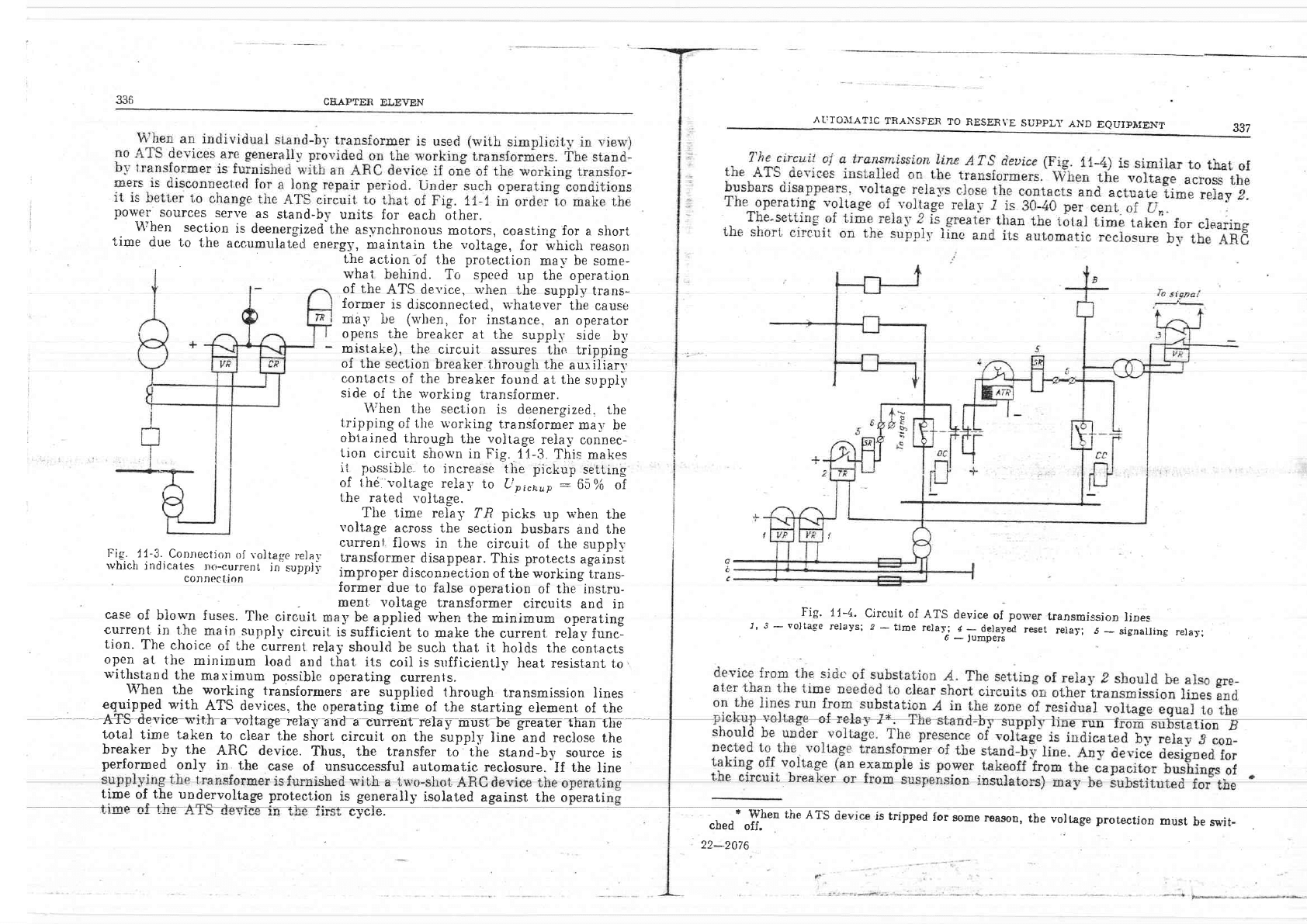
336
CEAPTEN
DLE]rEN
AIITO}IATIC
TRANSFER
TO
RESER\-E
SUPPLY
AhiD
EQUIP&fENT
337
power
sources
ser\re
as
stand-bv
units
for
each
other.
\47hen
section
is
deenergized
the
asvnchronous
motors, coasting
for a short
time
due
to the
accumulated
energ5,
maintain
the voltage,
for
ihich
reason
the
actionbf
the
protection
mav
be
some-
what
behind.
To
spced up
the
operat.ion
of tire
ATS device, rvhen
the
sunnlv
trans-
former
is disconnected,
rvhatevei
ih.
c"use
may
be
(u'lten,
for
instance.
an operator
opens
the
breaker
at
t,he suppll'
side
bv
rnistake),
the
circuit
assures
the tripping
of
the
section
breaker
throuelt
tire
auriLiar!
contacts
of the
breaker
found
at
the
suppIS'
side
of
the
working
transformer.
\\rhen
the
section
is
deenersized.
the
tripping
of
the rvorliing
transform"er
mav
be
obtained
through
the voltage
reia_v
connec-
tion
circuit
siiown
in Fig.
11-3.
This
makes
it possibie.
to
increase tire pickup
sett,ing
oJ tlrd'voltage
rela5'
1s
Ltpicxup
:
65
96
of
l.he
rated
voltage.
Tlie time
relal' Zfr picks
up
ri'hen
the
voltage
across the
section
busbars
and the
current
flows
in the
circuit
of
the
suppl,v
transformer
disappear.
This protects
against
improper
disconnection
of
the
working
trans-
former
due to
false
operation
of tire insLru-
FiC.
l1-3.
Connectjon
oI
r.olt,age
lelar,
rvhich
indicates
lrcl-current
in'sunpi!
connection
case
of biown
fuses
rhe
ci
rcur,
*#TJ
";;1n5'",rffT*t?*i,'Jt'jr3'xt,,il
current
in the
main
suppl-v
circuit issuffici-ent
to
make
the
current relav
func-
tion.
The
cJroice
of the
current
relay should
be such tirat
it
holds
t,he
contacts
open
at
the
minimum
load
and that
its
coil is
sufficient])'
heat
resistant
t.o'
withstand
t-h.
maximum
possiblc
operating
currents.
When
the_
wo1\ing
transformeri
are supplied
through
transmission
lines
eq]]pped
s'ith
ATS
devices,
the
operating time
of the
st*arting
eiement
of the
{+S devicrwith
a vo}tage
rela5'
6nd a
ciuent relay
must
ne
}reator
than
f,lie
total
time
taken
to
clear"
the
short
circuit
on
the
r'rppi),
Iine-and
reclose the
breaker by
the
ARC
device.
Tltus, the transfer
to
-the
stand-by
source
is
performed
onl-rr in
the
case
of unsuccessful
automatic
reclosure.
"If
the
line
Fig.
11-4.
1,3
-
voltage
relays;
Circuit
of
ATS
device
of
porver
transmission
.2
-
tirDe
relal;
I
-
delayed
reset
relay;
s
_
6
-
Jumpers
lines
signalling
relay;
time
of
the
undervoltage
protection
is
generally
isolated
against
the
operati
t lttt
"
wnen
[ne
A'1
s
ched
off.
99-9n7A
ts tripped
for
soms
reasonr
the
voltage
protection
must
be
swit-

338
CEAPTER
ELEVEN
AUTOMATIE
TRANSFER
TO
RESERVE
SUPPLT
AND
EQUIPMENT
339
6
ygl^tage
transformer.
Delaved
reset
rela-v
4
ensures
one-shot
operation
of the
ATS device.
If
the
supply
line
is furnished
with
a
two-shot
action
ARC device
installed
from the
side
of substation
,4 and
if after
the
second
ARC operation
the
iine
remains
under
voltage
the
return
of
the
substation
to the
main
po!\,er
source
is
best performed
manualiy
(locatly
or bv
means
of a remote-cbntrol
device).
(t)
device
using
ri'eight actuators
(a)
and
circujt
supplied
with rectified
alternating
current
(b)
Figure
t1-5b
illustrates
the
circuit
of an
ATS device
used
with
one-shot
ating
elements
are
combined
in
one relay
2ATR
with
an armature
reset
delay
_
To^improve
the
reset-to-pickup
rat
relay
2ATR
is
controlled
bv-the
contac
ATR
rared
for
110 volts
isLbout
f0 vr
mes
disconnected.
Its
auxiliary
contacts
make
the
b5'lupplv
breaker.
which
hai
been.
prglTe+
b5,
the
contact
of
rela-v
ZATy.
To
accelerate
the
operation
of the
ATS
devrces,
the
ttippi"g
of
the
main
pos'er
source
breaker
must
be
speeded-up.To
thi-s
end.
the
iirg.'"*.
shorx,n
in
{igt'
1l-1
and
11.2
have
circuits-which
i.tio.*
ruch
trippioe
o";."tions
$,hen
'uhe
breaker
at the
suppiS
side
of the
main
.u;plj'
tt"n.toril"t
T.
Jo.". It is more
compiicateti
ro
accelerate
the
acrion
of
erb'alri;;.*pi;"
jil;;r;;A;;
-"upplied
from
the
main
poyel-
sources
over
relari;-\'
il;;-it*slission
lines.
The possibilities
are
ls
follows:
(a)
To
protect
the
suppl5'
lines..use-maI,
be
made
of
a iongitudinal
diffe-
rential
protection
which
iiips
the
line
from
both
sraes
in
the
case
of
a
short
circuit.
(b)
Use
ma_v be
made
of
a
device
for
the
breaker
at the
supply
line
side
is
c
stance
l.Uuickl-v
acting
prot.ection
(a
cu
(c)
Tire
line
mal'
beJurnished
wirh
connects
the
line
from
both
sides
in
the
based
on
the
principle
of
protection
r*,it
ternal
short
circuits.
(d)
Use
ma1'
be
made
of der.ices
$,
real
porver
flou'*s
in
the
line.
Examples
e
operation
indication
rvith
the
aid
bf a
:
zing
a decrease
in the
frequencl
and
th
The
best
results
are
obiainei
b_,v
usi:
both
on the
lines
suppl5;ing
the
substa
p-orler
to
the
parallel
]oads.
This
ma]
the
time
relal-,
incorporated
in the
ATS
ment
of
any
type,
to
0.5
s.
i1-3.
A?S
Devicesgs"$
by
Substations
Supplying
Synehronous
Loads
G)
Fig.
11-5.
Circuit
of a.c.
ATS
of
ATS
device
.irrith
r.oltage
relal'
A
typical
scheme
used
to
su
power
to
many
industriai
enterprises
is
nted
b
own
substations
over tu,o
trunk
lines.
Co"or.iia
ra*i^-^ ^f ^^_^-_*^^_-r_
l-.-_l
to
each
trunk
hne
are
o?
ltotaJ.l.ti
L!\'eerl
t,nem.
the
case
of
an
phase
rectifier
b"ds;"t
;;;;;;"; ; i#;"Ir;ilir;;;i";;;.
Generally
this
breaker
is
open.
It is
clbsed
bv
the
ATS
device
in
22*
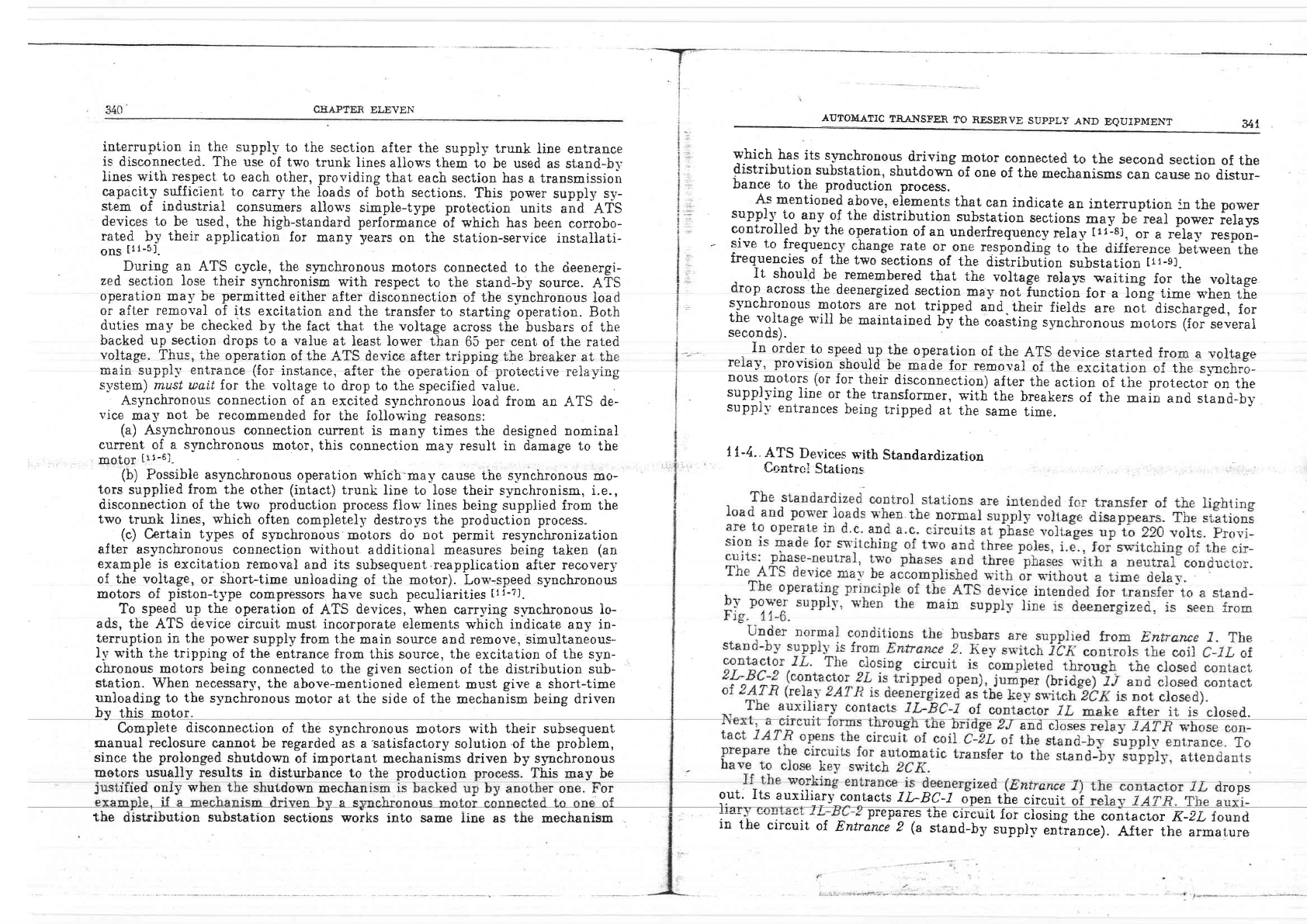
CIIAPTER
ELEVEN
interruption
in the
suppil,-
to the
section
after
the
supply
trunk line entrance
is
disconnected.
The use
of two
trunk lines
allows them
to
be
used
as stand-br,
Iines
with respect
to each
other,
providing
that
each
section has
a transmissioii
capacity
srrfficient
to
carry
the loads
of both sections.
This
power
supply s-v-
sten
of
industrial
consumers
allows
simple-type protection-
units
ana efS
devices
to
be
useC,
the
high-standard performance
of
*'hich
has
been
conobo-
rated
by
their
application
Ior many
years
on
the
station-service
instaliati-
ons
[1r-5].
During
aa
ATS cycle, the
synchronous
motors
connected
to
the
deenergi-
zed
section
}ose their
slmchronism
with
respect to
the
stand-by source.
ATS
operation ma-v
be
permitted
either
after disconnection
of
the
svnchronous load
oi af t,er
removal
ol its
excitation
and the
transfer
to starting
bperation.
Both
duties
may
be
checked
by the
fact that
the
voitage
across tf,e
tusbars
of
the
backed up section drops
to
a
value
at
Ieast
lower than
65
per
cent
of
the
rated
wnlf l.p Thrrc fho nnorof inn af +ho AT'Q .lorriaa oftar f-i^-in^ *!ra l,-^^1,^- ^+ +} ^
4vu
vr
uuv
t\rv uvrrvv
qruvr
urrlJpru6r
u49 llgqaEl au ugg
main
suppl;"
entiance (foi
insiance,
af"er
ihe
opera*r,ion
of
proiee^uive
reLa-ving
s.vstem) rnust wai.t
for the
voltage
to
drop to the
specified value.
Asynchronous connection
of
an
excited
synchronous
load from
an
ATS
de-
vice
may
not be
recommended
for
the
following reasons:
(a)
Asynchronous
connection current
is many
times
the designed nominal
current of
a synchronous
motor, this
connection
may resuit
in damage
to
the
motOr
[11-6].
(b)
Fossible
asynchronous
operation
which'may
cause the synchronous
mo-
tors
supplied
from
the
other
(intact)
trunk
line to lose
their synchronism, i.e.,
disconnection
of the
two
production prooess
fiow }ines being
supplied
from the
two
trunk
lines,
w-hich
often
cornpletely destro5's the
production process-
(c)
Crrtain
types
of synchronous
motors do
not permit
resynchronization
after asyncbronous
connection
rn'ithout
additional measures being taken
(an
example
is
excitation
removal
and
its subsequent reapplication after recovery
of
the voltage,
or short-time
unioading
of
th'e
motor). Low-speed
synchrooo*
motors
of
piston-type
compressors
have sueh
peculiarities
tl1-?1.
To
speed
up
the
operation
of
ATS
devices,
when
carr-r'ing
slnchronous
Io-
ads, the
ATS
device
circuit
must incorporate
elements
which indicate any in-
terruption
in
the power
supply
from t,he
main source
and remove,
simultaneous-
11,'with the
tripping
of
the
entrance from
this source,
the
excitation
of
the syn-
chronous motors being
connected
to the
given
section
of
the
distribution
sub-
station.
When
necessar]',
the
above-mentioned element
must
give
a
short-time
unioading
to the s-vnchronous
motor at the side
of
the
mecbanism being driven
by
this motor.
Complete
disconnection
of the
synchronous
motors
with their subsequent
manual reclosure
cannot be regarded
as a satisfactory solufion
of
the
problem,
since
the
prolonged
shutdown
of
important
mechanisms
driven
by slnchronous
AI]TOMATIC
TRANSFER
TO
RESERVE
SUPPLY.AND
EQUIP]TfENT
341
which
has
its s;mchronous
driving
motor
connected
to the
second
section
of the
distribution
substation,
shutdowi
of
one of the
mechanisms
can
sause
no d.istur-
bance
to
the production
process.
As
mentioned
above,
elements
that
can
indicate
an
interruption
in the power
supplS',to
qny
of the
distribution
substation
sections
may be'real
fower
irty;
controlied
b5r
the
operation
of an
underfrequency
relay
tri"-ri
-or-"
,5r.y
,..prir:
-
sive
to
freguenc-r'
change rate
or
on" trsponding
to
ihe
d.ifference
between
the
freq_uenr.ies
of
the
two
iections
of the
diitribution
substation
t11-sl.
It
should
be
remembered
that
the
voltage
reiays
*"iii"g
for
the voltage
drop-across
the
deenergized
section
pay
not
Function
for
a
fois-time
v'hen
the
synchronous
motors
aie
not
tripped
"od.th*ir
fields
are
not"discharged,
i;;
the voitage
wili
be
maintained
by
the
coaiting
synchronous
motors
(for"several
seconds).
In
order
to
speed
up the
operation
of
the
ATS device
started from a voltese
reiay. provision
should
be
made
for remor:a]
of the
excitation
J
th. =:*;h;;:
nous.rnot,ors
(or
for
their
disconnection)
after
the
action
of tire protectoi
on
the
suppl-ving
line
or tbe
transformer,
w-ith
the
breakers
of
the
main
and stand-bv
suppi_v
entrances
being
tripped
at
the
same
time.
I
1-4..
ATS
Device-s
with
Standard.ization
Contrcl
Sta{.ions
motors
wually
results
in disturbance to
the
production
This may be
ltrecl only
w
utoown
mecnan r
one.
ror
out.
Its
auxiliary
contacts
IL-BC-I
open
the
circuit
of
,he
circui'i
ior
ciosing
t,he
cont,actor
R-EL found
stand-by
supp)v
entlance).
After the
armature
rops
nnn hc r^A
yrrlJarED
the
tiistribution substation
sections
works
into same
Iine as
the
mechanism
in
the
circuit
of
Entrance
2
(a
